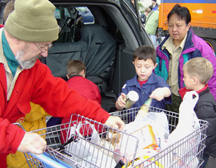Second Harvest finds food to meet needs of hungry people
Hunger persists in Spokane County. More than 16,000 people stand in lines every month at 21 outlets distributing food provided through Second Harvest and area food banks. Changing the manner of response are two factors, food producers are more efficient and volunteers are aging.
Despite these changes, Jason Clark, director of Second Harvest of the Inland Northwest, said the agency is finding ways to keep up with the needs. He is heartened by the generosity of people in the community.
 |
| Family receives food donations. |
Second Harvest deleted “food bank” from its name so people do not come to the distribution center thinking it is a food bank where they can receive assistance. The operation at 1234 E. Front in Spokane is a warehouse where trucks deliver food for sorting, storage or packaging, and then transport it to the outlets.
The 18th annual client survey, titled “Still in Line” includes the following statistics on hunger in the area:
• Of those seeking assistance, 42 percent are children and 11 percent are over the age of 55.
• More than three-fourths of those in line live on 30 percent of the Spokane County median income—$1,229 a month—or less.
• More than half of the primary wage earners surveyed worked at some point in the past year—44 percent worked at least six months.
• About 29 percent of households had an adult currently working full time or part time, 20 percent were looking for work but not finding, and 44 percent of primary wage earners did not work during the last year.
• Nearly 60 percent of parents are skipping some meals so their children will have food.
To reach more children, Second Harvest has started the Backpack Project through two schools with a high number of children on free lunches.
The schools will give at-risk children a box of food that fits in their backpacks.
“We balance cost, nutrition and what children will eat,” said Jason, showing a sample box that contained raisins, granola bars, applesauce, juice, crackers and cheese, jello and other snacks. “We also have to keep in mind allergies.”
To launch a trial run of the Backpack Project, Second Harvest raised $14,000 to help 150 children through the end of 2004. The project went from concept to implementation in three months of working with school districts in Spokane and Pasco.
Second Harvest is developing new ways to find food products.
“Changes in the food industry make it harder to come up with food resources to feed hungry people,” Jason explained. “The industry can donate food products only if farmers grow too much and if food manufacturers have excess inventory of safe, unmarketable products. To be competitive and productive, farmers and manufacturers have made improvements that reduce the availability of food from them.”
One way is through Grocery Rescue, going to retail grocery chains three to five times a week to pick up damaged, safe products, in contrast with going to wholesalers less often to pick up returned products.
This approach offers an opportunity to recover unmarketable product, Jason said.
Second Harvest now works with 10 retail stores and expects to have 20 by mid-2005.
Three years ago, Second Harvest received 1.8 million pounds of salvaged food products, but now the amount is down to 600,000 pounds.
The cost of grocery rescue is nine cents a pound, compared with five to six cents a pound with salvaged food delivered, because of the added transportation costs.
“Increased efficiency and better manufacturer inventory control have reduced the amount of dry goods, cereal and canned goods. Grocery Rescue brings more opportunity for fresh produce, frozen and refrigerated foods, but the food perishes.
“The challenge is to store it and send it out quickly. We have cold storage on site and off site, but food bank outlets have less cold storage,” Jason said. “Carrots, potatoes and apples have a good shelf life, but broccoli, radishes, pears and bagged salad mixes last only a few days.”
To add to its own efficiency, Second Harvest has a new 60-foot power conveyer to sort food from drives and salvage, and to build food boxes, backpack boxes and brown bags for seniors. It enables volunteers to do in one hour what they previously did in one day, Jason said.
He believes communicating the need will open people’s hearts, checkbooks and volunteer time.
“The challenge is the number of families living on the margins of the economy from Spokane to the Okanogan and in rural areas. The lines are not shorter. The gap between middle class and low income is widening,” he said.
Volunteers help at both the distribution center in Spokane and the 270 neighborhood food banks and meal banks Second Harvest serves in the Inland Northwest.
Many volunteers are “part of the greatest generation” of people giving their time, he said, and are now in their 80s, slowing in their ability to assist.
“Who will take over running neighborhood food banks as they step down?” he wonders. “Baby boomers are working later into life. We hope that as they retire, they will be free in terms of time and income so they can step in to volunteer.”
Volunteers come not only to give food out but also to keep shelves stocked, record intake and inventory, unload trucks. It takes 20 to 30 volunteers a week to run some food banks.
Churches and agencies continue to help with food drives for neighborhood outlets, but Second Harvest provides more than 70 percent of food given out.
A recent regional study attributes the increase in hunger to high unemployment in the Northwest, to the high cost of living and to mobility as people seek more affordable housing.
“We need to respect the lives of people who come through the system,” Jason said.
He told of a 55-year-old homemaker whose husband had a good job and provided a comfortable living for the family. He died of a heart attack. She was in a food-bank line for the first time.
Many families on the edge of the economy and society are in the lines. Some seniors have to choose between medicine and food. One took a reverse mortgage to pay for medicine and taxes, but was needed food.
Jason said it’s not that those in lines did anything wrong. Most are just struggling to eke out an existence and pay for food.
“Most feel a cross between humility, embarrassment and anger as they stand in line,” he said.
The need is self-declared. Each is asked to verify whether the family income is within the federal poverty guidelines. Agencies take social security numbers and cross reference names to find if they are going to more than one food bank.
For information, call 534-6678.
By Mary Stamp, Fig Tree editor - Copyright © December 2004 - The Fig Tree




